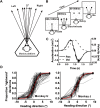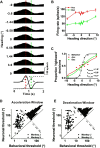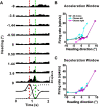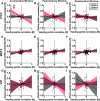Dynamics of Heading and Choice-Related Signals in the Parieto-Insular Vestibular Cortex of Macaque Monkeys
- PMID: 33622780
- PMCID: PMC8026344
- DOI: 10.1523/JNEUROSCI.2275-20.2021
Dynamics of Heading and Choice-Related Signals in the Parieto-Insular Vestibular Cortex of Macaque Monkeys
Abstract
Perceptual decision-making is increasingly being understood to involve an interaction between bottom-up sensory-driven signals and top-down choice-driven signals, but how these signals interact to mediate perception is not well understood. The parieto-insular vestibular cortex (PIVC) is an area with prominent vestibular responsiveness, and previous work has shown that inactivating PIVC impairs vestibular heading judgments. To investigate the nature of PIVC's contribution to heading perception, we recorded extracellularly from PIVC neurons in two male rhesus macaques during a heading discrimination task, and compared findings with data from previous studies of dorsal medial superior temporal (MSTd) and ventral intraparietal (VIP) areas using identical stimuli. By computing partial correlations between neural responses, heading, and choice, we find that PIVC activity reflects a dynamically changing combination of sensory and choice signals. In addition, the sensory and choice signals are more balanced in PIVC, in contrast to the sensory dominance in MSTd and choice dominance in VIP. Interestingly, heading and choice signals in PIVC are negatively correlated during the middle portion of the stimulus epoch, reflecting a mismatch in the polarity of heading and choice signals. We anticipate that these results will help unravel the mechanisms of interaction between bottom-up sensory signals and top-down choice signals in perceptual decision-making, leading to more comprehensive models of self-motion perception.SIGNIFICANCE STATEMENT Vestibular information is important for our perception of self-motion, and various cortical regions in primates show vestibular heading selectivity. Inactivation of the macaque vestibular cortex substantially impairs the precision of vestibular heading discrimination, more so than inactivation of other multisensory areas. Here, we record for the first time from the vestibular cortex while monkeys perform a forced-choice heading discrimination task, and we compare results with data collected previously from other multisensory cortical areas. We find that vestibular cortex activity reflects a dynamically changing combination of sensory and choice signals, with both similarities and notable differences with other multisensory areas.
Keywords: PIVC; bottom-up; choice; partial correlation; sensory; top-down.
Copyright © 2021 the authors.
Figures








Similar articles
-
Evidence for a Causal Contribution of Macaque Vestibular, But Not Intraparietal, Cortex to Heading Perception.J Neurosci. 2016 Mar 30;36(13):3789-98. doi: 10.1523/JNEUROSCI.2485-15.2016. J Neurosci. 2016. PMID: 27030763 Free PMC article.
-
Convergence of vestibular and visual self-motion signals in an area of the posterior sylvian fissure.J Neurosci. 2011 Aug 10;31(32):11617-27. doi: 10.1523/JNEUROSCI.1266-11.2011. J Neurosci. 2011. PMID: 21832191 Free PMC article.
-
Functional specializations of the ventral intraparietal area for multisensory heading discrimination.J Neurosci. 2013 Feb 20;33(8):3567-81. doi: 10.1523/JNEUROSCI.4522-12.2013. J Neurosci. 2013. PMID: 23426684 Free PMC article.
-
The parieto-insular vestibular cortex in humans: more than a single area?J Neurophysiol. 2018 Sep 1;120(3):1438-1450. doi: 10.1152/jn.00907.2017. Epub 2018 Jul 11. J Neurophysiol. 2018. PMID: 29995604 Review.
-
Visual and vestibular cue integration for heading perception in extrastriate visual cortex.J Physiol. 2011 Feb 15;589(Pt 4):825-33. doi: 10.1113/jphysiol.2010.194720. Epub 2010 Aug 2. J Physiol. 2011. PMID: 20679353 Free PMC article. Review.
Cited by
-
The Neural Mechanisms of Visual and Vestibular Interaction in Self-Motion Perception.Biology (Basel). 2025 Jun 21;14(7):740. doi: 10.3390/biology14070740. Biology (Basel). 2025. PMID: 40723301 Free PMC article. Review.
-
Temporal and spatial properties of vestibular signals for perception of self-motion.Front Neurol. 2023 Sep 13;14:1266513. doi: 10.3389/fneur.2023.1266513. eCollection 2023. Front Neurol. 2023. PMID: 37780704 Free PMC article. Review.
-
Contrary neuronal recalibration in different multisensory cortical areas.Elife. 2023 Mar 6;12:e82895. doi: 10.7554/eLife.82895. Elife. 2023. PMID: 36877555 Free PMC article.
-
Why is vestibular migraine associated with many comorbidities?J Neurol. 2024 Dec;271(12):7422-7433. doi: 10.1007/s00415-024-12692-8. Epub 2024 Sep 20. J Neurol. 2024. PMID: 39302416 Review.
-
Parietal maps of visual signals for bodily action planning.Brain Struct Funct. 2021 Dec;226(9):2967-2988. doi: 10.1007/s00429-021-02378-6. Epub 2021 Sep 10. Brain Struct Funct. 2021. PMID: 34508272 Free PMC article. Review.
References
Publication types
MeSH terms
Grants and funding
LinkOut - more resources
Full Text Sources
Other Literature Sources
